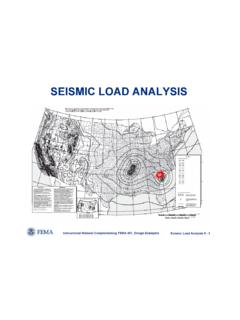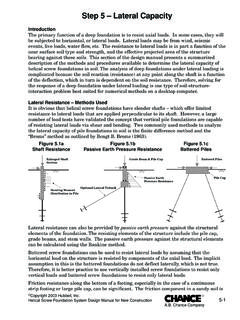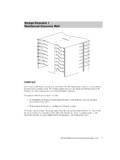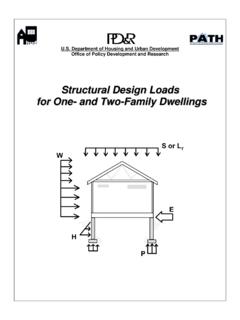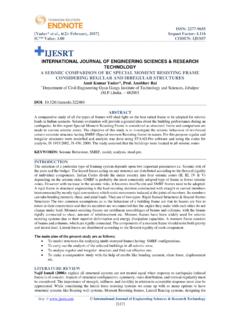Transcription of PRECAST CONCRETE CONSTRUCTION - World …
1 PRECAST CONCRETE CONSTRUCTION . Svetlana Brzev, British Columbia Institute of Technology, Canada Teresa Guevara-Perez, Architect, Venezuela BACKGROUND. The concept of PRECAST (also known as prefabricated ) CONSTRUCTION includes those buildings where the majority of structural components are standardized and produced in plants in a location away from the building, and then transported to the site for assembly. These components are manufactured by industrial methods based on mass production in order to build a large number of buildings in a short time at low cost. The main features of this CONSTRUCTION process are as follows: 1. The division and specialization of the human workforce The use of tools, machinery, and other equipment, usually automated, in the production of standard, interchangeable parts and products This type of CONSTRUCTION requires a restructuring of the entire conventional CONSTRUCTION process to enable interaction between the design phase and production planning in order to improve and speed up the CONSTRUCTION .
2 One of the key premises for achieving that objective is to design buildings with a regular configuration in plan and elevation. Urban residential buildings of this type are usually five to ten stories high (see Figures 1. and 2). Many countries used various PRECAST building systems during the second half of the 20th century to provide low-income housing for the growing urban population. They were very popular after the Second World War, especially in Eastern European countries and former Soviet Union republics. In the former Soviet Union, different PRECAST buildings systems are denoted as Seria, whereas in Romania they are called Sec iunea.. In general, PRECAST building systems are more economical when compared to conventional multifamily residential CONSTRUCTION (apartment buildings) in many countries. The reader is referred to the UNIDO2 report for detailed coverage on PRECAST systems and their earthquake resistance. Figure 1: Typical large-panel buildings in Kyrgyzstan (WHE Report 38) and Russian Federation (WHE Report 55).
3 PRECAST CONCRETE CONSTRUCTION Figure 2: A typical PRECAST slab-column building (WHE Report 68, Serbia and Montenegro). CATEGORIES OF PRECAST BUILDING SYSTEMS. PRECAST buildings constitute a significant fraction of the building stock in the republics of the former Soviet Union and Eastern European countries. These systems have been described in the following eight WHE reports: 32 (Kazakhstan); 33, 38, and 39 (Kyrgyzstan);. 55 (Russian Federation); 66 (Uzbekistan); 68 (Serbia and Montenegro); and 83 (Romania). Depending on the load-bearing structure, PRECAST systems described in the WHE can be divided into the following categories: Large-panel systems Frame systems Slab-column systems with walls Mixed systems Large-Panel Systems The designation large-panel system refers to multistory structures composed of large wall and floor CONCRETE panels connected in the vertical and horizontal directions so that the wall panels enclose appropriate spaces for the rooms within a building.
4 These panels form a box-like structure (see Figure 3). Both vertical and horizontal panels resist gravity load. Wall panels are usually one story high. Horizontal floor and roof panels span either as one-way or two-way slabs. When properly joined together, these horizontal elements act as diaphragms that transfer the lateral loads to the walls. Figure 3: A large-panel CONCRETE building under CONSTRUCTION (WHE Report 55, Russian Federation).. PRECAST CONCRETE CONSTRUCTION Depending on the wall layout, there are three basic configurations of large-panel buildings: Cross-wall system . The main walls that resist gravity and lateral loads are placed in the short direction of the building. Longitudinal-wall system . The walls resisting gravity and lateral loads are placed in the longitudinal direction; usually, there is only one longitudinal wall, except for the system with two longitudinal walls developed in Kazakhstan (WHE Report 32). Two-way system . The walls are placed in both directions (Romania, WHE Report 83).
5 Thickness of wall panels ranges from 120 mm for interior walls (Kyrgyzstan, WHE report 38). to 300 mm for exterior walls (Kazakhstan, WHE Report 32). Floor panel thickness is 60 mm (Kyrgyzstan). Wall panel length is equal to the room length, typically on the order of m to m. In some cases, there are no exterior wall panels and the fa ade walls are made of lightweight CONCRETE (Romania, WHE Report 83). A typical interior wall panel is shown in Figure 4. Figure 4: PRECAST interior wall panel with steel dowels and grooves (WHE Report 38, Kyrgyzstan). Panel connections represent the key structural components in these systems. Based on their location within a building, these connections can be classified into vertical and horizontal joints. Vertical joints connect the vertical faces of adjoining wall panels and primarily resist vertical seismic shear forces. Horizontal joints connect the horizontal faces of the adjoining wall and floor panels and resist both gravity and seismic loads.
6 Depending on the CONSTRUCTION method, these joints can be classified as wet and dry. Wet joints are constructed with cast-in-place CONCRETE poured between the PRECAST panels. To ensure structural continuity, protruding reinforcing bars from the panels (dowels) are welded, looped, or otherwise connected in the joint region before the CONCRETE is placed. Dry joints are constructed by bolting or welding together steel plates or other steel inserts cast into the ends of the PRECAST panels for this purpose. Wet joints more closely approximate cast-in-place CONSTRUCTION , whereas the force transfer in structures with dry joints is accomplished at discrete points.. PRECAST CONCRETE CONSTRUCTION Figure 5 shows a plan of a large-panel building from Kazakhstan with the connection details. In this system , vertical wall panel connections are accomplished by means of groove joints, which consist of a continuous void between the panels with lapping horizontal steel and vertical tie-bars.
7 Horizontal joint reinforcement consists of dowels projected from the panels and the hairpin hooks site-welded to the dowels; the welded length of the lapped bars depends on the bar diameter and the steel grade. Vertical tie- bars are designed for tension forces developed at the panel intersections. Lateral stability of a large-panel building system typical for Romania is provided by the columns tied to the wall panels (WHE Report 83). Boundary elements (called bulbs in Romania) are used instead of the columns as stiffening elements at the exterior, as shown in Figure 6. The unity of wall panels is achieved by means of splice bars welded to the transverse reinforcement of adjacent panels in the vertical joints. Longitudinal dowel Figure 5: Plan of a large-panel building showing vertical connection details (WHE. Report 32, Kazakhstan). Figure 6: A. typical building plan showing the locations of boundary members (WHE. Report 83, Romania).. PRECAST CONCRETE CONSTRUCTION bars placed in vertical and horizontal joints provide an increase in bearing area for the transfer of tension across the connections.
8 Wall-to-floor connection is similar to that shown in Figure 5. Frame Systems PRECAST frames can be constructed using either linear elements or spatial beam-column subassemblages. PRECAST beam-column subassemblages have the advantage that the connecting faces between the subassemblages can be placed away from the critical frame regions; however, linear elements are generally preferred because of the difficulties associated with forming, handling, and erecting spatial elements. The use of linear elements generally means placing the connecting faces at the beam-column junctions. The beams can be seated on corbels at the columns, for ease of CONSTRUCTION Figure 7: Components of a PRECAST reinforced CONCRETE frame system of Seria IIS-04 (WHE Report 66, Uzbekistan). and to aid the shear transfer from the beam to the column. The beam-column joints accomplished in this way are hinged. However, rigid beam-column connections are used in some cases, when the continuity of longitudinal reinforcement through the beam-column joint needs to be ensured.
9 The components of a PRECAST reinforced CONCRETE frame are shown in Figure 7. PRECAST reinforced CONCRETE frame with cruciform and linear beam elements (Seria 106) is an example of a frame system with PRECAST beam-column subassemblages (Kyrgyzstan, WHE Report 33). The system was developed in Kyrgyzstan in 1975. The load-bearing structure consists of a PRECAST reinforced CONCRETE space frame and PRECAST floor slabs. The space frame is constructed using two main modular elements: a cruciform element and a linear beam element (Figure 8). The cruciform element consists of the transverse frame joint with half of the adjacent beam and column lengths. The longitudinal frames are constructed by installing the PRECAST beam elements in between the transverse frame joints. The PRECAST elements are joined by welding the projected reinforcement bars (dowels) and casting the CONCRETE in place. Joints between the cruciform elements . PRECAST CONCRETE CONSTRUCTION Figure 8: A perspective drawing showing cruciform and linear units (WHE Report 33, Kyrgyzstan).
10 Figure 9: Hollow-core PRECAST slab (WHE Report 33, Kyrgyzstan). are located at the mid-span of beams and columns, whereas the longitudinal PRECAST beam-column connections are located close to the columns. Hollow-core PRECAST slabs are commonly used for floor and roof structures in this type of CONSTRUCTION , as shown in Figure 9. Slab-Column Systems with Shear Walls These systems rely on shear walls to sustain lateral load effects, whereas the slab-column structure resists mainly gravity loads. There are two main systems in this category: Lift-slab system with walls Prestressed slab-column system Lift-slab systems were introduced in the last decade of the Soviet Union (period 1980-1989) in some of the Soviet Republics, including Kyrgyzstan, Tadjikistan, and the . PRECAST CONCRETE CONSTRUCTION Caucasian region of Russia, etc. This type of PRECAST CONSTRUCTION is known as Seria KUB.. The load-bearing structure consists of PRECAST reinforced CONCRETE columns and slabs, as shown in Figure 10.


